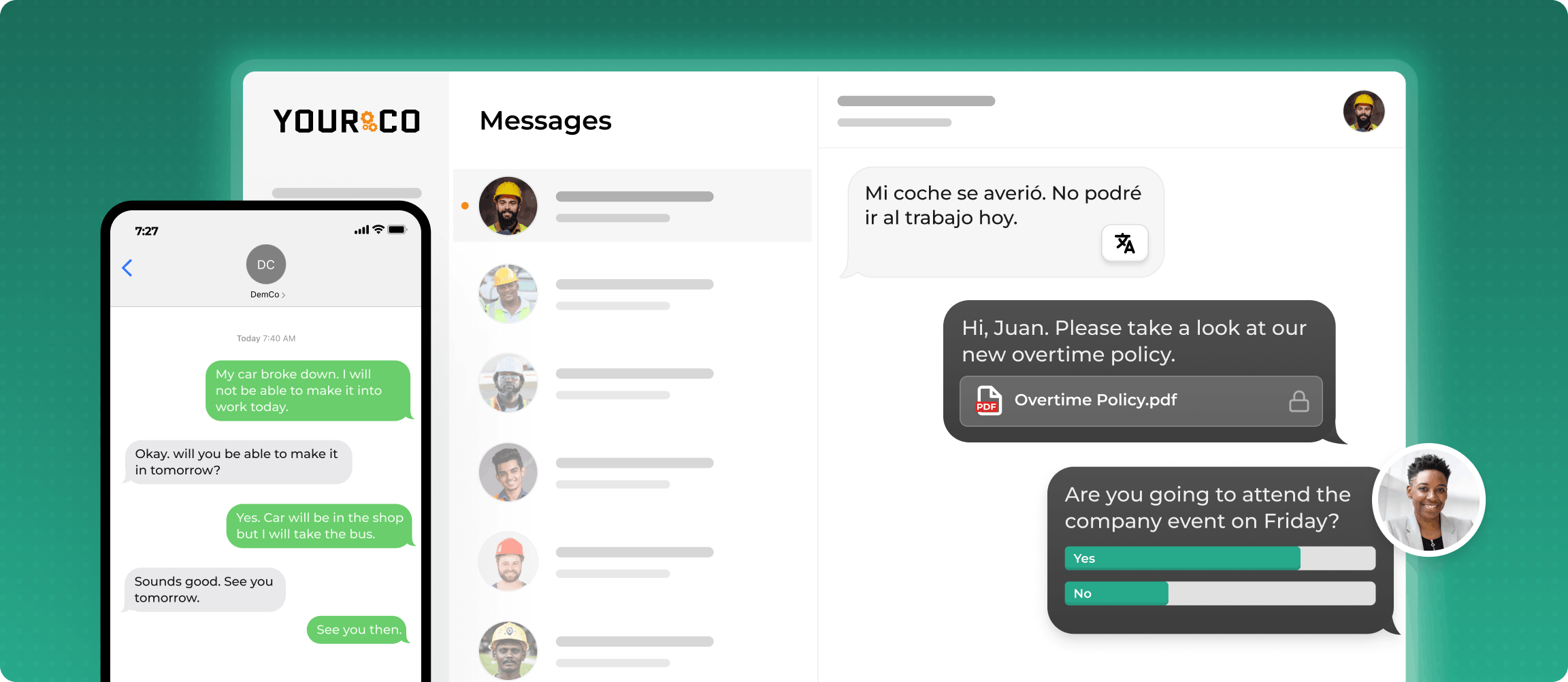Shift Swap: A Powerful Tool for Happier Employees and Smooth Operations


Shift swaps are powerful tools for creating happier employees and ensuring smooth operations. But many managers struggle with messy processes, compliance worries, and fairness issues that turn this simple concept into a daily headache. Success with shift swaps comes down to clear systems that balance employee flexibility with business needs (especially for non-desk workers facing unique scheduling challenges). When you implement shift swaps correctly, you create a win-win situation where employees gain more control over their time while businesses maintain proper coverage and operational continuity.
Shift Swap: Definitions, Benefits & Key Risks
Let's get clear on what we're talking about. A shift swap happens when two employees voluntarily exchange their scheduled work shifts with management approval. This differs from a shift cover, where one employee temporarily covers another's shift without a trade, and voluntary overtime, where employees work extra hours for additional pay. Understanding these definitions can help you tackle scheduling conflicts more effectively.
Smart shift swap policies deliver real benefits. Organizations report a 35% reduction in unplanned absences when employees can arrange coverage through swaps rather than calling out sick. Employee satisfaction scores jump by an average of 28% when workers gain scheduling flexibility, which directly improves retention rates and cuts recruiting costs.
You'll also enjoy better operational continuity. Instead of scrambling to fill last-minute gaps or paying premium rates for emergency coverage, you maintain consistent staffing through employee-driven solutions. This saves money while freeing managers from hunting for coverage.
Fairness matters tremendously. One healthcare provider discovered their informal shift swap system mainly benefited senior nurses, causing complaints from junior staff about favoritism. This hurt team morale and required HR to step in with transparent, equitable policies.
Your success depends on finding the sweet spot between flexibility and structure, so you can ensure your shift swap program helps rather than hurts your operations.
Shift Swaps and Why Fairness Matters
Fairness in shift swap approvals directly affects your program's success and employee happiness. When employees see inequity in how managers handle shift swaps, team morale suffers and turnover rises. A healthcare provider learned this lesson when their informal system consistently favored senior nurses, leaving junior staff feeling marginalized and forcing HR to rebuild their entire approach.
Fair systems need transparency and equal opportunities. Try employee rotation systems for popular shifts, so the same people don't always claim desirable weekend or holiday coverage. Make your approval criteria crystal clear so everyone understands what qualifies for approval. Communicating changes to employees ensures transparency and trust in the process. Regular pattern analysis helps you catch potential favoritism before it becomes problematic.
Your eligibility requirements should create a level playing field. Avoid policies that put newer employees at a disadvantage because they haven't built the same network of potential shift swap partners as veteran staff. Consider waiting periods or experience requirements that make sense and apply to everyone equally.
To support fairness and boost morale, consider implementing compensation strategies for deskless employees that recognize their unique challenges and contributions.
The business case is simple: fair shift swap policies reduce complaints, boost engagement, and create a positive work environment where everyone gets equal access to scheduling flexibility. This translates to better retention and higher productivity across your team.
When Shift Swaps Don't Work
While shift swaps offer valuable flexibility, certain scenarios create operational problems or legal risks that demand careful attention. Recognizing these warning signs helps you keep operations running while protecting your business and employees.
Last-minute requests cause major headaches for managers. What counts as "last-minute" varies by industry. Manufacturing facilities typically require 48-72 hours advance notice due to production planning and safety protocols, while retail environments might handle same-day changes with less trouble. For urgent situations, create clear escalation procedures including management approval and verification that the substitute employee can safely handle required tasks.
Overtime problems emerge when shift swaps accidentally push employees beyond their regular hours. Under the Fair Labor Standards Act, employers must pay overtime for all hours worked over 40 in a workweek, regardless of how employees accumulated those hours through swaps. A simple favor between coworkers can trigger unexpected labor costs without proper monitoring. Always check total weekly hours before approving any shift swap request.
Other scenarios require extra caution. During critical periods like product launches or busy seasons, keeping your strongest team composition becomes essential. When jobs require specific certifications or skills, such as in manufacturing plants where employees need identical safety certifications, unrestricted shift swaps can compromise safety and quality. Employees with existing attendance issues shouldn't use shift swaps to hide ongoing reliability problems. In such cases, managers must focus on handling no shows and addressing attendance concerns directly.
For these challenging situations, consider alternatives like offering premium pay for hard-to-fill shifts, cross-training more employees to expand your qualified pool, or implementing temporary scheduling adjustments instead of relying on potentially problematic shift swaps.
Manager Workflow: From Request to Approval
Managing shift swaps effectively requires a systematic approach that balances employee flexibility with operational needs. This six-step workflow provides a clear framework you can implement right away to streamline approvals while maintaining compliance and coverage.
Step 1: Confirm Policy Allows the Shift Swap
First, quickly verify the request meets your established criteria. Check if both employees work in the same department, have equivalent qualifications, and meet any tenure requirements. Good policies restrict swapping to employees with similar training and experience to maintain service quality. Also check that neither employee has attendance issues or disciplinary actions that might disqualify them.
Step 2: Intake Request
You have several options for receiving shift swap requests. Digital portals work for office staff, but SMS platforms like Yourco excel for non-desk workers without regular computer access. Paper forms work for smaller teams but create extra administrative work. Text messaging offers the fastest response times and highest engagement, making it valuable for urgent requests or last-minute coverage.
Step 3: Run Labor-Law & Overtime Checks
Before approving any shift swap, verify it won't create compliance violations. Check if the arrangement pushes either employee over 40 hours for the week, triggering overtime requirements. Confirm adequate rest periods between shifts and ensure the change doesn't violate state-specific break requirements. These checks play a crucial role since schedule changes can accidentally create overtime liability.
Step 4: Route to Leadership Approval
Determine which level of management needs to approve the shift swap based on your policy. Include essential information like employee names, shift details, reason for the change, and your compliance verification. Some organizations let supervisors approve routine requests while requiring higher approval for holiday coverage or critical periods.
Step 5: Update the Live Schedule
Once approved, immediately update all scheduling systems to reflect the shift swap. This prevents confusion and ensures payroll accuracy. Send the updated information to your time-tracking system and any integrated HR platforms to maintain data consistency.
Step 6: Receive Instant Notifications & Archive
Make sure all affected parties receive notification of the approved shift swap. This includes both employees involved, their direct supervisors, and any support staff who need schedule visibility. Archive all documentation for compliance purposes and future reference. Good record-keeping protects you during audits and helps identify patterns that might inform policy adjustments.
Managing Non-Desk Team Shift Swaps via SMS
Traditional shift swap methods fail non-desk workers who spend their days on factory floors, construction sites, or delivery routes. Email systems and company intranets become useless when employees don't have computer access, and workers often miss phone calls during busy work periods. This communication gap exacerbates the challenges faced by non-desk employees, leading to unfilled shifts, last-minute scrambles, and frustrated managers struggling with managing shift changes effectively.
Text-based communication platforms solve this problem by reaching employees wherever they work. Users read nearly 100% of text messages, typically within 90 seconds of receipt. This immediate reach transforms how quickly teams can coordinate and confirm shift swaps.
Text-based platforms like Yourco work on any phone without requiring smartphones or reliable data connections. This removes technology barriers, ensuring every team member can participate regardless of their device or tech comfort level. Real-time confirmation and tracking create accountability while maintaining detailed documentation.
Multilingual support matters for diverse workforces, with platforms supporting over 135 languages to ensure clear communication and to overcome language barriers. Managers can send shift swap announcements, receive requests, and provide approvals all through simple text exchanges. The system keeps detailed records of every interaction, creating the audit trail needed for compliance while streamlining the entire process. This approach transforms shift swap coordination from a time-consuming burden into an efficient, employee-driven system that works for everyone.
Building a Fair & Compliant Shift Swap Policy
Creating a solid shift swap policy requires careful attention to both operational needs and employee rights. Your policy forms the foundation for maintaining fairness while ensuring business continuity, especially for non-desk teams with unique scheduling challenges.
Start with clear eligibility requirements that define who can participate. Most successful policies restrict shift swaps to employees within the same department or position who have equivalent training, experience, and performance levels. Manufacturing environments typically require identical safety certifications or equipment qualifications. Healthcare settings focus on clinical credentials and patient care experience. This prevents situations where critical skills go missing while maintaining operational quality.
Your approval process should establish a clear hierarchy that balances speed with oversight. Effective policies require supervisor approval for all shift swaps, ensuring management maintains visibility into schedule changes and can verify that both employees meet necessary qualifications. Specify what information you need for approval requests: the reason for the shift swap, confirmation of equivalent skills, and verification that neither employee will exceed overtime thresholds.
Notice periods vary by industry and should reflect your operational realities. Manufacturing facilities often require 48-72 hours advance notice to accommodate production planning and equipment assignments, while retail environments might allow shorter windows due to more standardized job functions. Always include provisions for emergency situations that require expedited approval processes, such as family emergencies or sudden illness.
Documentation requirements form the backbone of compliance and fairness monitoring. Your policy should require recording all shift swap requests, approvals, denials, and the reasoning behind each decision. This creates an audit trail that protects both employees and management while helping you identify patterns that might indicate favoritism or policy abuse. Proper documentation also ensures accurate payroll processing and helps resolve disputes.
Establish blackout dates when shift swaps face restrictions or require additional scrutiny. These typically include peak business periods, inventory counts, major project deadlines, or times when specific skill sets are critically needed. Communicate these dates well in advance so employees can plan accordingly and understand the business reasoning behind the restrictions.
Overtime limits prevent unexpected labor cost increases and ensure compliance with labor laws. Your policy should include automatic checks that prevent changes from pushing employees over 40 hours per week unless specifically approved by senior management. This protection helps avoid both compliance violations and budget overruns while maintaining predictable labor costs.
Consistent enforcement ensures your shift swap policy maintains credibility and fairness. Train all supervisors on the approval criteria and establish regular reviews of shift swap patterns to identify potential issues. When employees understand that the policy applies equally to everyone, they're more likely to respect the process and view it as a legitimate tool for workplace flexibility rather than a system that can be manipulated.
Legal & Labor Law Considerations
Staying compliant with labor laws isn't optional; it's essential for protecting your organization from costly violations and legal disputes. Understanding key legal requirements helps you create shift swap policies that work for everyone while keeping you safe.
As mentioned before, overtime remains your biggest compliance challenge. The Fair Labor Standards Act requires overtime pay for all hours worked over 40 in a workweek, regardless of how employees scheduled or swapped those hours. Effective managing overtime compliance ensures that your company stays within legal requirements. When employees exchange shifts, you must still track their total weekly hours to ensure proper overtime calculations. The FLSA regulations (29 CFR § 553.31) specifically address substitutions, clarifying that employers should credit each employee as though they worked their original schedule for pay purposes.
State-specific break and meal period requirements add another layer of complexity. While federal law doesn't mandate specific break lengths, many states do. California requires a 30-minute meal break for every 5 hours worked, and other states have similar requirements. When you approve shift swaps, especially those involving extended hours or double shifts, you must verify that employees can take all mandatory breaks.
Predictive scheduling laws continue to expand across major cities and states, requiring advance notice of work schedules and predictability pay for last-minute changes. These laws can trigger penalty payments when changes occur without sufficient notice, even if employees initiate them voluntarily. Cities like Seattle, San Francisco, and New York enforce strict requirements that can cost you hundreds of dollars per violation.
Documentation protects you from disputes and audits. You should keep records of all shift swap requests, approvals, and actual hours worked. You need this paperwork during wage investigations or employee grievances. Digital platforms like Yourco automatically create audit trails, making compliance tracking much simpler for managers handling multiple daily requests.
In unionized environments, collective bargaining agreements may supersede general company policies on scheduling changes. Review your union contracts carefully to understand any restrictions, seniority requirements, or special approval processes that apply to shift swaps. Some agreements require union representative approval for certain types of changes, which can add time to your approval process.
Frequently Asked Questions
What if no one picks up a shift?
Set clear escalation timelines when posting available shifts. Give employees 24-48 hours to claim the opening, then escalate to management for alternative coverage. Consider offering premiums or incentive pay to encourage pickup. If the original employee can't find coverage and no volunteers emerge, they remain responsible for their scheduled shift unless management approves the absence. Document these situations to identify patterns and adjust your policy accordingly.
Does a shift swap that increases hours over 40 become overtime?
Yes, absolutely. Any employee working over 40 hours in a workweek must receive overtime pay, regardless of how those hours were scheduled or swapped. Track total weekly hours across all swapped shifts and calculate overtime accordingly. Your approval process should include automatic checks to flag potential overtime situations before confirming any shift swap.
How do you deny a shift swap fairly?
Use objective criteria consistently applied to all requests. Valid reasons include inadequate notice, skills mismatch, coverage gaps, or potential overtime violations. Communicate denials clearly with specific reasons rather than vague explanations. Document your decision-making process to demonstrate fairness and consistency across all employees.
Can employees with different skill levels swap shifts?
Only if both employees meet the minimum qualifications for each other's positions. Manufacturing environments often require identical certifications for safety reasons. Healthcare settings need equivalent clinical credentials. Always verify that exchanging employees can perform required tasks safely and effectively before approval.
How do you handle employees who consistently avoid certain shifts through swaps?
Monitor shift swap patterns to identify potential abuse. Set limits on how frequently employees can swap out of specific shifts. Address pattern abuse through coaching conversations before implementing disciplinary measures. Consider rotating assignments to ensure fair distribution of less desirable shifts across your team.
How quickly should managers respond to shift swap requests?
Ideally, managers should respond to shift swap requests within 24 hours. This gives employees enough time to make necessary arrangements while ensuring the request doesn't become a last-minute issue. For urgent situations, consider implementing an expedited review process with clear guidelines on what qualifies as an emergency.
Make Shift Swaps Work for Everyone

Effective shift swap programs deliver measurable benefits across multiple business areas while creating the workplace flexibility that today's workforce demands. The key lies in balancing structured processes with employee autonomy, ensuring your shift swap policy enhances rather than complicates daily operations. Start with the quick-start checklist and build from there. Your team will appreciate the flexibility, and your operations will run more smoothly.
To make managing shift swaps even easier, Yourco offers a seamless solution, especially for non-desk employees who often lack access to email or company intranets. By using SMS technology, Yourco ensures that all employees can request, confirm, and receive shift swap reminders directly on their mobile phones. This platform works even without internet access or advanced devices, bridging communication gaps in environments where traditional methods fail.
Yourco also documents all shift swap interactions in real time, providing a detailed audit trail for compliance and transparency. This makes it easier for managers to track approvals, prevent last-minute scheduling issues, and stay compliant with labor laws, such as overtime regulations. Automated reminders and notifications ensure that employees are always up to date with their schedules, reducing the risk of confusion or missed shifts.
With Yourco, businesses can streamline shift swap processes, boost employee satisfaction by offering more flexibility, and enhance operational continuity. By combining employee autonomy with clear, documented workflows, Yourco helps create a more efficient, transparent, and engaged workplace.
Try Yourco for free today or schedule a demo and see the difference the right workplace communication solution can make in your company.



